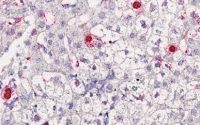Study identifies potential target for treating systemic inflammation in obesity

A study led by researchers at the University of Chicago and Indiana University has determined that a protein called elF5A is necessary for driving inflammation in macrophage cells in obesity. Blocking DHPS, the enzyme that modifies and activates elF5A, led to reduced inflammation and improved glucose control in mice. The study was published on September 7 in Cell Metabolism.
DHPS is a conserved protein, meaning that it is found in many different animal species from bacteria to humans. It has mostly been studied in yeast and other cultured cells. While the lab of Rhagu Mimira, MD, Ph.D., has studied DHPS for years, little was known about its role in inflammation or obesity. “When I joined the lab as a postdoc, I was interested to see if the DHS pathway could be a common thread promoting inflammation both in the pancreas, as Dr. Mirmira’s lab had shown, and in the setting of adipose tissue meta-inflammation,” said Emily Anderson-Baucum, Ph.D., a former postdoctoral scholar at Indiana University.
The researchers focused on the downstream effects on the e1F5A protein, which DHPS activates by modifying a lysine amino acid to generate a rare amino acid called hypusine. Once activated, elF5A has impacts on mRNA translation that affect processes like cell proliferation, differentiation and apoptosis. Importantly, elF5A has been implicated in the translation of mRNAs associated with inflammation. How mRNAs are translated can affect which proteins are expressed within a cell, and in turn, how that cell functions.
“ElF5A is important in the production of other proteins because of its effects on mRNA translation, but it only does this when cells are under stress,” said Mirmira, Professor of Medicine at UChicago Medicine. “This often is actually protective, but a protective process can become destructive if the stress is ongoing, and can eventually kill the cell. Obesity is an example of an environment that tends to put a lot of stress on our cells, which can trigger these inflammatory pathways that normally would not be triggered. So, we wanted to determine what role these two proteins play in obesity, and in particular in the macrophages—cells that we know play a role in inflammation in obesity.”
The researchers found that in mice that were fed a high-fat diet and became obese, there was an increase in the expression of DHPS, and the activated form of elF5A— elF5AHyp—was enriched in macrophages found in adipose tissue. Macrophages, a type of white blood cell, play a role in the immune system by gobbling up and disposing of foreign and dead cells. Increased expression of elF5AHyp led to an increase in the number of inflammatory macrophages.
“We hypothesized that this upregulation was maladaptive, and so we thought that maybe if we blocked DHPS in mice, we could stop this process,” said Mirmira. “And when we blocked this enzyme, we were able to alter the way that the macrophages behaved. They weren’t behaving in an inflammatory way anymore. And even though the animals got obese, they didn’t exhibit metabolic dysfunction, and they didn’t get hyperglycemia.”
When the researchers looked into the mechanism by studying immune cells that had been genetically modified to eliminate DHPS expression, they saw that by knocking out DHPS, there was an overall reduction in mRNA translation in inflammatory macrophages, and a reduction in the secretion of some proteins associated with inflammation. In mice, the researchers were able to knock out DHPS only in macrophages, and found that doing so led to a decrease in inflammation and improved glycemic control, even though the mice still became obese after being fed a high-fat diet.
“These results really allow us to dissociate simple weight gain from the subsequent diabetes that often is seen in obesity,” said Mirmira. “Simply knocking out the enzyme in macrophages was enough to have an effect.”
Mirmira says that these results are strong evidence that macrophages are crucial for the development of the inflammation seen in obesity, and that addressing this inflammation may be a key component of treating obesity and its complications. “We know that with a high-fat diet, macrophages are more inclined to be inflammatory,” he said. “The DHPS enzyme seems to be the trigger that makes those macrophages inflammatory. So, without this enzyme, you don’t get the consequences of inflammation.”
The researchers were surprised to find that a single enzyme could be pivotal in the way that macrophages behave. “There are so many proteins involved in inflammation, and we seem to have distilled it down to a single protein that plays a key role,” said Mirmira.
The next steps will be to better understand the complete pathway, including the DHPS enzyme and elF5A, and to see if it’s possible to develop a small molecule that is capable of blocking the DHPS enzyme in humans. “Obesity and eating a high-fat diet—both of which are common in U.S.—are hard on the body,” said Mirmira. “The implication here is that if you are obese, we know that your adipose tissue is likely very inflammatory and creating a setting that can lead to diabetes. And insulin is a therapy for diabetes, but it doesn’t address the underlying pathology of what’s going on in obesity. So, developing a small molecule that could block DHPS could be a more directed option for treating that inflammation.”
The team is already investigating at least one small molecule, already approved by the FDA for use in humans, that blocks an enzyme upstream of DHPS, which they think may be able to block the same pathway and could therefore be a much easier and faster route toward a treatment. Developing such a treatment could provide new opportunities for the management of obesity and its associated diabetes.
Source: Read Full Article


